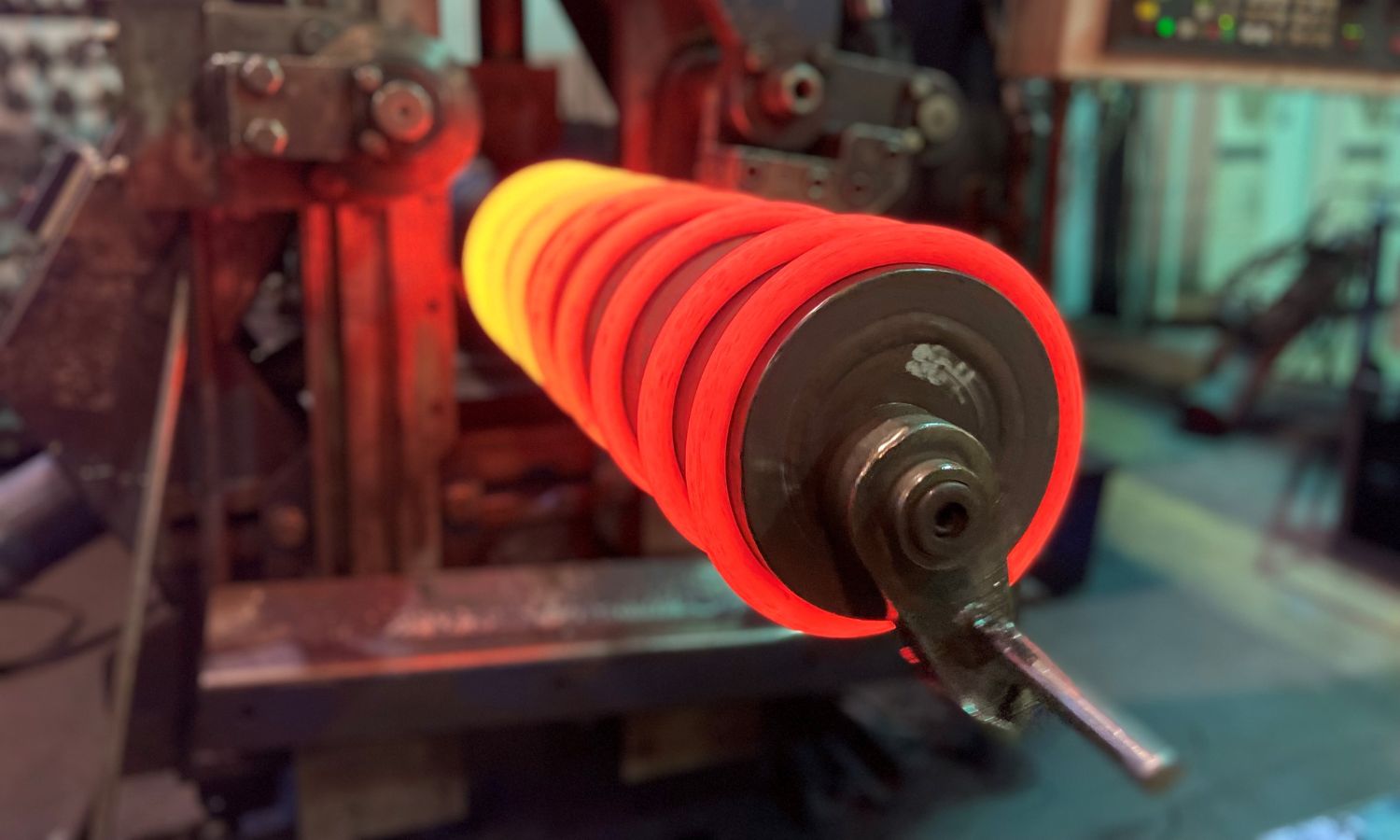Please complete the form below, and one of our experts will be in touch.
If you would like to send a technical drawing with your enquiry, please email heavysprings@lesjoforsab.com

In this comprehensive article, we delve deeply into the critical role that compression spring material selection plays in the performance of springs. We'll examine how different materials affect the springs' functionality, durability, and suitability for specific applications. Our focus will be on the properties, benefits, and practical applications of these materials, providing insights into the importance of choosing the right material for optimal spring functionality. Join us as we delve into the essential aspects of compression spring materials and their impact on manufacturing excellence.
Compression springs are essential components in a myriad of applications, ranging from automotive assemblies to electronic devices. Characterised by their helical shape, these springs are designed to compress under applied force, providing resistance and storing energy. Their versatility lies in their ability to support various compressive loads, making them integral in maintaining the functionality and integrity of mechanical systems. Crafted with precision, compression springs are a testament to the ingenuity of modern engineering, offering reliable performance in diverse operational environments.
The functionality of compression springs revolves around Hooke's Law, a principle stating that the force exerted by the spring is directly proportional to the displacement it undergoes. When a compression spring is subjected to a load, it contracts, absorbing energy. This energy is subsequently released as the spring returns to its original length when the load is removed. This mechanism of energy absorption and release underpins the operational efficiency of compression springs, making them indispensable in systems where controlled movement or cushioning is required.
Selecting the appropriate material for compression springs is pivotal, as it dictates their performance, durability, and suitability for specific applications. Factors such as tensile strength, corrosion resistance, and operating temperature range are crucial considerations. Materials like stainless steel or Inconel are chosen based on these criteria, each offering distinct advantages. For instance, stainless steel is favoured for its all-around strength and corrosion resistance, making it ideal for general-purpose applications, whereas Inconel is preferred in high-temperature environments due to its superior heat resistance. The material choice, therefore, is a critical decision that directly impacts the efficacy and longevity of compression springs in their respective applications.

Common materials used to manufacture compression springs include stainless steel, carbon steel, chrome silicon and chrome vanadium. Speciality materials such as Iconel and non-ferrous metals are also used for their specific properties.
Stainless steel is a highly preferred material for compression springs due to its remarkable combination of strength, corrosion resistance, and durability. Its inherent ability to withstand challenging environments, including those with moisture or corrosive elements, makes it an ideal choice for a wide range of applications. Stainless steel springs are commonly used in automotive, marine, and medical sectors, where longevity and reliability are paramount.
Carbon steel stands out as a cost-effective and versatile material for compression springs. Renowned for its high tensile strength and robustness, carbon steel is suitable for heavy-duty applications with high stresses. This material is often selected for industrial equipment, machinery, and automotive components due to its excellent performance in terms of strength and fatigue resistance. However, it requires protective finishes to prevent corrosion, unlike stainless steel.
Alloy steels are steels that have been mixed with various alloying elements to enhance certain properties like strength, hardness, wear resistance, and toughness. These elements, such as chromium, nickel, manganese, molybdenum, vanadium, and silicon, are added in varying proportions to achieve specific characteristics. The addition of these elements in steel changes its physical and chemical properties, making alloy steels more suitable than carbon steel in certain applications.
Chrome Silicon is a distinguished alloy steel used in spring manufacturing, revered for its impressive resilience and strength, especially at higher temperatures. Its composition enhances its performance in environments where traditional spring steels may not perform well, such as in high-performance racing vehicles. Its excellent resistance to high temperatures and its ability to maintain strength and flexibility under extreme stress make it suitable for such uses; a preferred material in applications that demand a high strength-to-weight ratio and robustness in challenging thermal conditions.

Chrome Vanadium is another key player in the realm of alloy steels for springs. This material is celebrated for its excellent tensile strength and fatigue resistance. Its unique properties, derived from the addition of chromium and vanadium, offer enhanced performance in demanding mechanical environments. This alloy is commonly used in applications requiring high endurance and resistance to shock loads, such as in vehicle suspension springs.
The use of Chrome Silicon and Chrome Vanadium in high-stress environments is a testament to their superior qualities. These materials are integral in crafting springs that are exposed to extreme stress, fluctuating temperatures, and heavy loads. Applications range from automotive suspension systems to industrial mining machinery, where the reliability and durability of the springs are crucial. The resilience and longevity of these alloy steels under such strenuous conditions underline their importance in advanced manufacturing sectors.
Various speciality materials are used in compression springs to achieve results in extreme temperatures and harsh environments. Here are some examples of speciality materials, their properties and useful applications.
Inconel is a renowned speciality material in spring manufacturing, valued for its extraordinary ability to maintain strength and resist corrosion even under extreme temperatures. This nickel-chromium-based superalloy is ideal for applications in harsh environments, such as in compression springs for jet engines.

Elgiloy, a cobalt-chromium-nickel alloy, stands out for its excellent fatigue life, high strength, and corrosion resistance. It is particularly useful in environments where springs are exposed to corrosive substances or require non-magnetic properties. This makes Elgiloy a preferred choice in implantable medical devices because of its biocompatibility, as well as popular in aerospace and marine applications because of its stability in harsh environments.
Titanium springs are celebrated for their exceptional strength-to-weight ratio and corrosion resistance. Their lightweight nature makes them ideal for aerospace and automotive industries, where reducing weight without compromising strength is crucial. Additionally, titanium's biocompatibility is beneficial in medical implants and devices, showcasing its versatility across various high-tech sectors.
Non-ferrous metals offer further benefits of use, including electrical conductivity and non-magnetic properties. Let’s take a look at these in more detail…
Phosphor Bronze is a non-ferrous metal alloy, esteemed for its electrical conductivity, resilience, and corrosion resistance. This makes it particularly suitable for electrical applications, including springs in connectors and switches. Its consistent performance and durability under cyclic loads ensure reliable and long-lasting functionality in these critical components, where maintaining a stable electrical connection is paramount.
Beryllium Copper is another significant non-ferrous metal used in spring manufacturing, prized for its unique combination of high strength, electrical conductivity, and non-magnetic properties. This alloy is particularly beneficial in springs for electrical and electronic applications, such as contact springs and connectors for smartphones. However, it can also be used in industrial machinery. Its ability to maintain its properties in varying temperatures and environments makes it a versatile choice for precision instruments and aerospace components.
Various treatments and coatings can greatly enhance a compression spring's lifespan. So, let’s take a look at these treatments in more depth…
Nickel coating on springs significantly advances surface treatment, offering enhanced corrosion resistance and increased durability. This type of coating is particularly beneficial in environments where springs are exposed to harsh chemicals or extreme temperatures. Its application not only extends the lifespan of the springs but also ensures their consistent performance over time, making them more reliable in critical applications.
Galvanised steel, achieved by coating steel with a layer of zinc, is a widely used treatment in spring manufacturing to prevent corrosion. This process is especially useful for springs that are exposed to outdoor environments or moist conditions, where they are susceptible to rust. Galvanisation not only protects the steel from environmental factors but also prolongs the life of the spring, ensuring its functionality and structural integrity over a prolonged period, resulting in a heavy-duty compression spring material.
Selecting the right material for compression springs is a critical decision that influences their performance and longevity. Factors such as environmental exposure, operational stress, temperature ranges, and specific application requirements must be considered. Understanding the properties of materials like stainless steel, carbon steel, alloy steels, speciality materials, and non-ferrous metals can guide the selection process, ensuring that the chosen material aligns with the functional demands and environmental conditions of the application.
The future of compression spring materials is leaning towards innovation and sustainability. Advancements are expected in developing materials with higher strength-to-weight ratios, enhanced corrosion resistance, and improved fatigue life. The integration of nanotechnology and the development of new alloy compositions are also anticipated. These advancements aim to enhance performance while also addressing environmental concerns, making springs more efficient and sustainable.
Seeking expert advice is crucial when dealing with the complexities of compression spring materials and applications. As specialists in this field, we can provide valuable insights into material selection, design optimisation, and application-specific requirements. Our expertise enables us to design and develop the perfect spring for your needs, prototype samples and use our advanced hot and cold coiling technologies to coil springs from 3mm to 65mm wire diameter so that you receive the perfectly crafted product at the right price.
If you have further questions or want to know more, you can read common questions about manufacturing springs. Can’t find the answer? Get in touch to find out how we can help you manufacture high-quality, heavy-duty compression springs.
Compression springs are typically made from high-tensile steel, stainless steel, or specialist alloys. Material selection is based on the spring’s load requirements, operating environment, and durability needs.
For extreme strength and fatigue resistance, Inconel and other nickel-based alloys are among the strongest materials used in spring manufacturing, especially in high-temperature or corrosive environments.
The best metal for a spring depends on the application. Stainless steel offers corrosion resistance, and chrome-silicon or Inconel excels under high stress or temperature.
Yes, springs can be made from engineering plastics like acetal or nylon for light-duty, non-conductive, or corrosion-sensitive applications, but they can’t match metal springs for strength or longevity.
Identifying spring material typically involves visual inspection, magnetism tests, and chemical analysis or material certification from the manufacturer.
We are world-leading heavy duty spring manufacturers, delivering the greatest expertise in compression, torsion and tension spring manufacturing.
Delivering impact to every industry, we guarantee spring solutions that will optimise your performance and success.

